After my tea this morning, I felt infinitely better. In fact, I’m feeling quite normal now.
Maybe all I missed was just tea. Forget about sleeping 24 hours. Forget about medicine. Tea is magic!

After my tea this morning, I felt infinitely better. In fact, I’m feeling quite normal now.
Maybe all I missed was just tea. Forget about sleeping 24 hours. Forget about medicine. Tea is magic!
Categories: Misc · Old Xanga posts
Tagged: musings
No updates yesterday because, well, I didn’t drink any tea yesterday. I was down with a fever after that very long and unpleasant flight. I didn’t want to drink tea in that kind of condition.
I’m now drinking some Lapsang Souchong to cure my caffeine headache. It was getting unbearable. I am brewing it more or less English style with a big white porcelain pot. My instinct is to pull the leaves out much sooner than I probably should, but even after only about two minutes of infusion the tea is already wonderfully smokey, but at the same time smooth and sweet.
Categories: Misc · Old Xanga posts · Teas
Tagged: black tea
I went and met up with Dogma and D today at Royal East. Dogma has already written about his previous experience at Royal East with Corax here. A scholar from my school who goes by the net name of Indra also joined us.
We met over lunch and chatted, with Dogma brewing up some darjeeling in those typical big pots of Chinese restaurants. It was rather strange drinking darjeeling at a Chinese restaurant, but it was good darjeeling.
When we were about done with dinner… we all started motioning for our teas. I pulled out one of the teas I bought from Hong Kong… the loose, broken cake that is well aged and rather smooth. It is a Guangyungong cake, vintage unknown. I suspect we have 30 years old pieces mixed in it, but also stuff of more recent vintage in there. Wet stored, I think, but mellow and sweet. Dogma commented on the clarity of the liquor despite the dark colour, and indeed, the colour of the tea is rather attractive. We drank it from the big pots in big cups, sort of like how you’re supposed to drink puerh. Puerh is better when you’re drinking in big gulps rather than tiny sips.
A few rounds after, Indra pulled out his traveling set, which includes a gaiwan, 6 small cups, and a small fairness cup. It’s quite handy, actually. He then pulled out the tea he was going to make — a rougui, medium roasted. He brews it in a rather unique way, one I haven’t seen before. The gaiwan is filled with tea leaves — I’d say 90% full. He pours the water in carefully, and waits…. for a long time. Whereas I would generally pour out the tea within 5-10 seconds, he waited at least half a minute with the first infusion, and subsequent infusions were even longer.
The resulting quality of the tea is rather darker than I imagined, mostly because of the long steeping time. It’s a bit rough from the tannins that got released, but full of the roasted flavour. The tea itself would’ve yielded a much weaker brew if brewed quickly. It was definitely interesting to see somebody make tea in a way that is very different from your own.
Meanwhile, we were still gulping down the puerh while getting the occasional rounds of rougui. We chatted about teas and other things, and the owner of the place, Otto, joined us. Dogma had to leave early, and we stayed on for another hour or so before heading out our respective ways.
It was definitely a fun time, and I wish we had more free time to drink teas. Oh well, that will probably have to wait till next time.
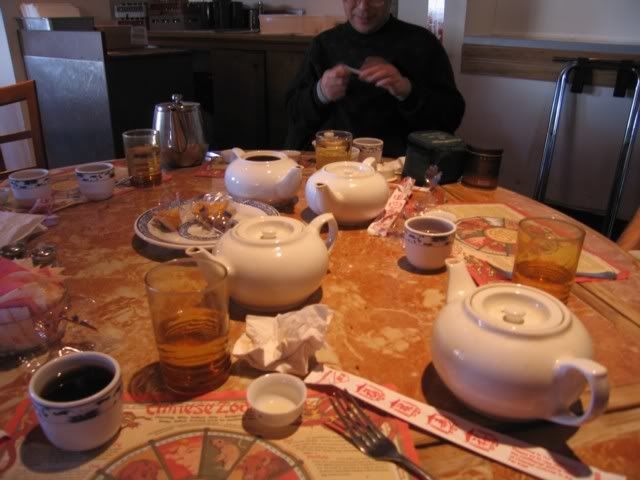
When we were leaving the table — requisite fortune cookies plus a lot of used teapots 🙂
Categories: Old Xanga posts · Teas
Tagged: aged puerh, Chinese oolong, friends, traditional stored puerh, travel, wuyi yancha
Now that I am back in Boston, I went and pulled up one of the teas I left behind, the Jabbok loose puerh, that I haven’t had since I left.

The tea… is quite nice in a way. It’s got some nice camphor aromas up front, pretty intense aroma, and it’s got a bit of depth in the way of an aftertaste. However, the tea seems thin, and it’s not very rebrewable.
Third infusion

Seventh infusion
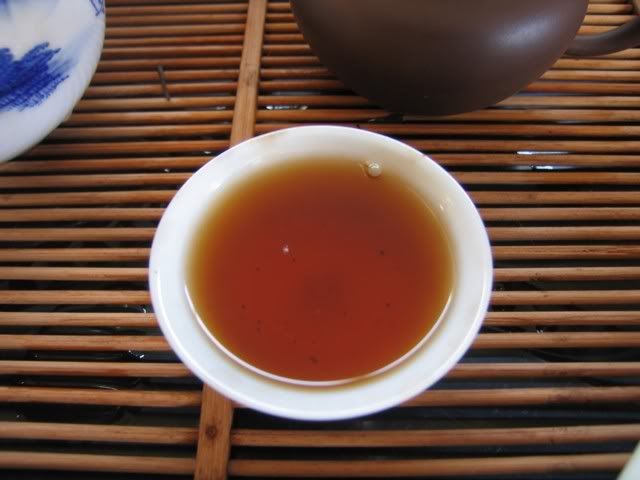
With truly good old teas, the tea will lose the colour but still has a taste — or an aftertaste. In this case, I find this tea dying fairly quickly. You can still let it sit with water and brew an infusion given long enough brewing time, but it’s not quite the same.
The leaves though tell me that these are definitely aged raw puerh. I would think this is at least 20 years old — otherwise it won’t taste the way it does
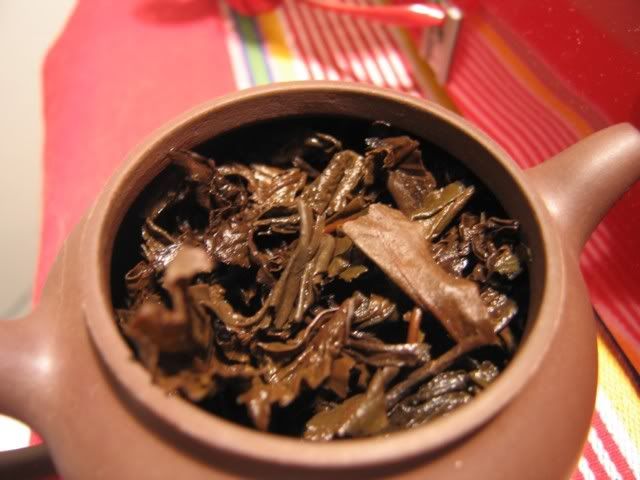
I still regret not having bought more when I had the chance. Now it’s gone forever. Oh well. I guess I have other things to drink.
Categories: Old Xanga posts · Teas
Tagged: aged puerh, traditional stored puerh
I’m bored, sitting here in EWR (Newark Liberty International Airpot) after what is probably the worst flight I’ve ever had in terms of service, and waiting now for my weather delayed connection to get into town so I can take it and then go back to Boston. I hate flying. You can guess what airline I’m flying by deduction.
So while I’m sitting here, bored, I figured I might as well blog, especially since I have pictures to show you. Thank god for Wifi in the airport (too bad you have to pay here — in HKG the Wifi at the airport is free!).
On the plane I’ve developed the habit of drinking the Yiwu maocha I have if I happen to be carrying it around, and this time on my lovely 14.5 hours flight it was no exception. I was finally starting to feel a bit of the caffeine headache at around 11pm Hong Kong time, after not having had tea for a whole day and some, so I took out my bag, brought it to the galley where the lazy flight attendants were sitting around reading Star!, and I asked for some hot water and put my tea in it.
The tea itself I won’t describe, as there is not much to say — it’s mild, sweet, kinda nice, kinda bland. The water is never hot enough for tea on the plane, so it’s really not a great way to drink tea. Oh well, it still beats the whatever mystery tea they are serving (I think it’s some really bad, overbrewed jasmine — didn’t try it this time).
Anyway, after drinking the tea, I laid out all the tea leaves I used and took some pictures, as it was a good way to kill time, among other things.
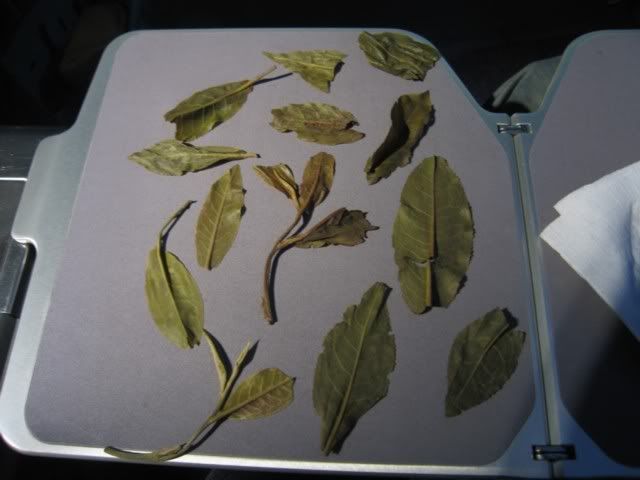
Some comparative pics — comments after
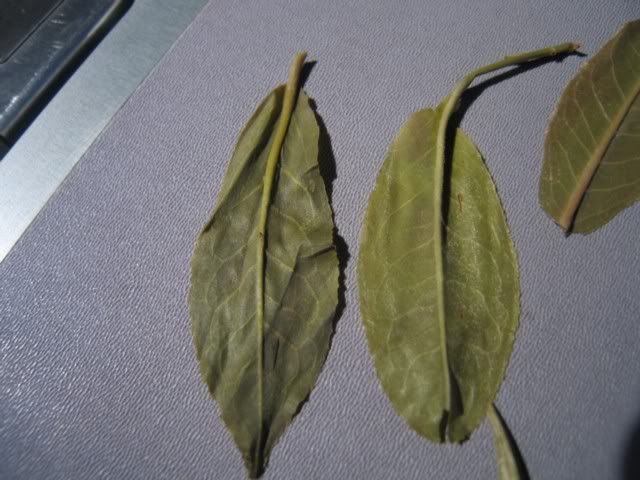
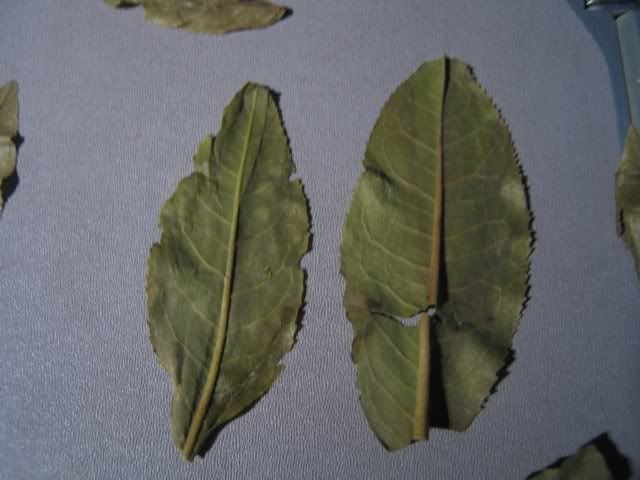
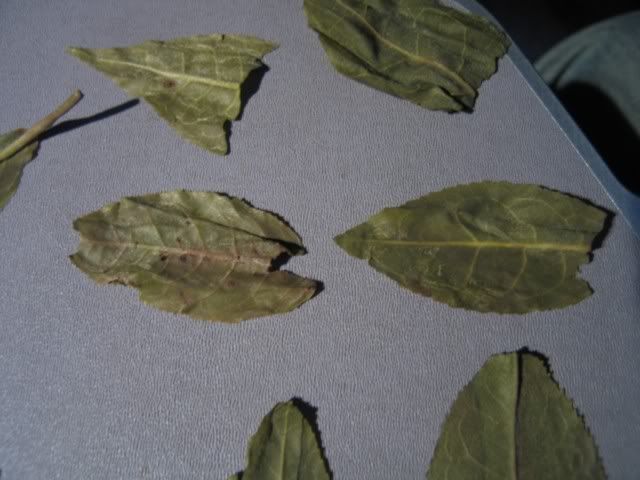
For the first two pictures in the above three… you can see two similarly sized leaves that are shaped quite differently. The ones on the left, with the thin, elongated shape and the pointy tip, is what I understand as a typical Yiwu leaf. The ones on the right, with the more rounded shape and no pointy tip, is what I understand to be NOT Yiwu like. I think that sort of shape is much more common in Menghai area leaves… nannuo, banzhang, jingmai, that sort of thing.
The third pic in the above three has a few broken leaves. The one on the top left is really pointy, and is only a tip of what looks to be a very large leaf. The two in the middle… the left one looks more like a Menghai type leaf, while the one on the right looks more like a Yiwu area type leaf. I’m not sure if this is really sceintific to any degree, and supposedly, with older trees, all the leaves look different because they are not planted by human intervention (i.e. not transplanted with branches from older trees). Instead, they were planted long ago using seeds. This means that the teas can have different genetic makeup. However, it does seem that different areas do have different kinds of teas, and so looking at the shape of the leaves can say something about where the teas came from. If I am not mistaken in this case… then I was probably right when I said, long time ago, that I thought this particular maocha tastes slightly confused with a few different kinds of teas mixed in, and not tasting quite like pure Yiwu.
I would really encourage everybody to take pictures of brewed leaves, and post them up. It is especially instructive when in a particular cake that is advertised as “xxx” that you find different kinds of leaves that look drastically different. It might be a sign of blending.
Lastly… a picture of a very nice, very furry bud. This is what I guess you can call “two spears, one flag”. Too bad the flag is slightly broken. I had to unpeel the bud myself to reveal the smaller bud in the middle, so perhaps this is really a “one spear, one flag”. I could sort of see a even smaller bud in there, but couldn’t quite get it out.
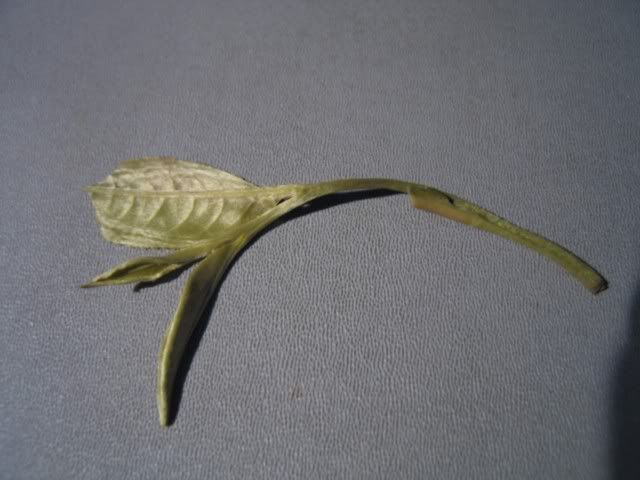
Back to waiting…
Categories: Old Xanga posts · Teas
Tagged: travel, young puerh
I went to the Best Tea House again… and tried that Yiwu small arbour sample that I have. Interesting observation — the tea got better, and changed character, since last time.
I don’t know what it is, but last time the tea brewed a rather insipid and boring tea, but this time, it’s much more flavourful. It’s still a bit on the weak side, but it came out a lot better. Part of it has to do with the sheer amount of leaves used, but I think the other reason is because it’s really changed a bit…. it’s different from the last three times I’ve had it.
Humidity here today is 98%. Somehow I think the taste change has to do with the very high humidity in Hong Kong. I think it ultimately makes teas change faster, and probably better. After all, almost all the older stuff we have on the market today came through Hong Kong. I am more and more convinced that a place like Beijing will develop terrible tasting teas.
Categories: Information · Old Xanga posts
Tagged: storage, young puerh
I stayed at home today, and had a rougui given to me free by one of the tea vendors on Maliandao.
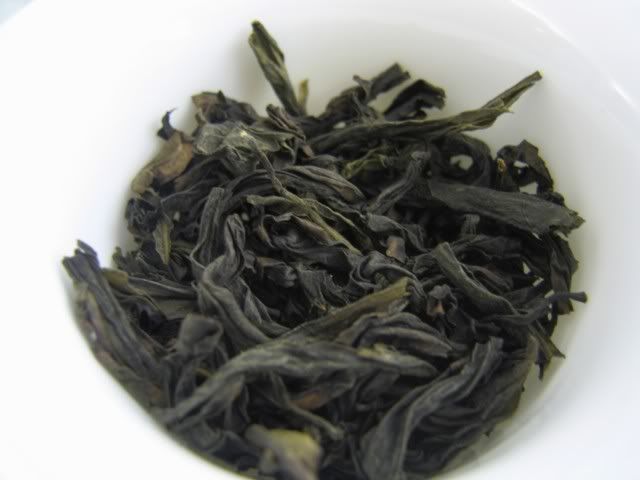
The leaves are a little green, and indeed, this is a relatively light roasted rougui.
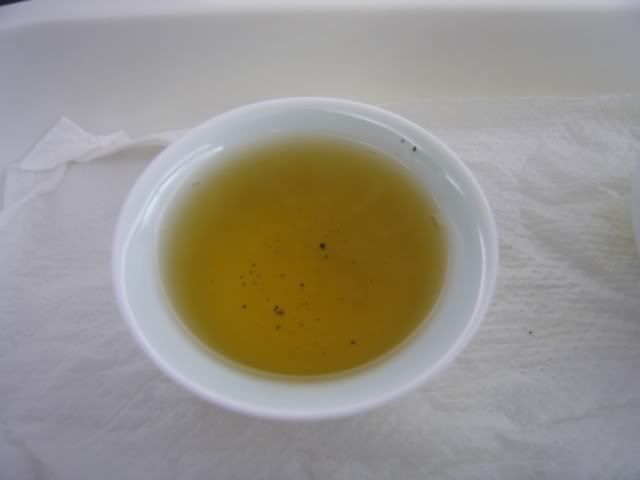
The tea is…. quite nice. Thick, with a deep aftertaste, and a nice up front aroma. The tea is not particularly complex, but it lasts many infusions. Then again, I’m not a huge fan of lightly roasted oolongs. Even though the tea is still relatively pleasant to drink, it doesn’t really cut it for me. I think for Wuyi teas, I still prefer stronger stuff that is more heavily roasted. It got slightly boring at the end.
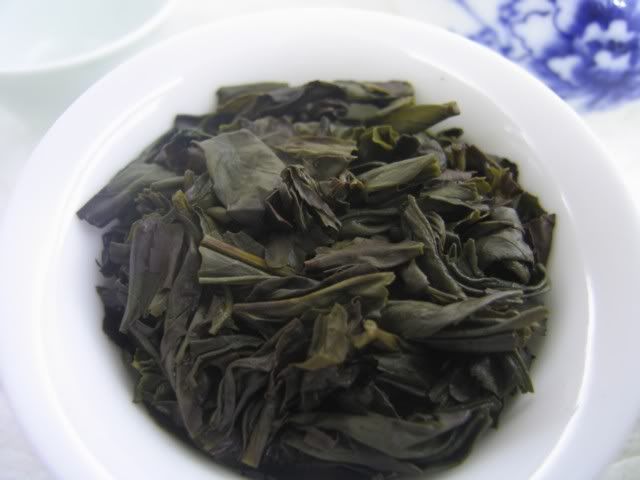
Categories: Old Xanga posts · Teas
Tagged: Chinese oolong, wuyi yancha
I am looking for a place to store my teas in Hong Kong, and there’s a cabinet in the house that will do the job well, I think. One problem though — it smells of varnish still, mostly because the door is rarely open. What can get rid of the varnish smell quickly? Any thoughts? Will charcoal do it? Should I go buy a bag of charcoal, open it, put it in the cabinet, and so when I return to Hong Kong next time, I can stick my tea (from Beijing) in the cabinet without having to worry about them all smelling like varnish?
I don’t have many days left in Hong Kong, so I might do a little last minute shopping around, although mostly, I am just going to hang out at home. Then it’s back to Cambridge for me.
Categories: Information · Old Xanga posts
Tagged: storage, travel
When drinking a large variety of teas, one ends up encountering a lot of stuff that is surprising, and most of them are not pleasantly surprising. Since teas are unlabeled, with unknown source and unknown provenance, what the vendor tells you is all you really know about it until you’ve tried it. Even then, it’s not always obvious what happened to the tea to cause it to be the way it is.
I had two teas today, both of which were a bit off.
The first was a puerh sample I have from somebody. I no longer remember who gave it to me, what it was, or really anything about it. I brewed it up at the BTH, hoping to try it and see if I can remember anything from it. The tea tasted like a Menghai tea. What struck me, however, was the extreme cloudiness of the tea. It looked like a chicken soup with the chicken meat ground up in it. The tea was really, really cloudy…. I was a little afraid of drinking it, even (and that’s a rare thing). Cloudiness is supposed to be a product of high moisture content in the tea, but this was just a little too high. Rosa said that apparently some tea makers, at least she heard anyway, made teas that were mixed or coated with a sort of rice liquid. This gives the tea more body when you drink it, but of course, it clouds up the tea. I seriously wonder if this was done to this particular tea. The cloudiness didn’t improve until maybe the 6th infusion. The taste of the tea was fine… not too bad, in fact. I could feel the power of the tea, although it’s a little unstable. Overall though, I don’t think I’d buy something like this.
The second thing was a special grade Tieluohan, a Wuyi tea from the BTH. I brewed it like I normally would… and it was sour. The second infusion was so sour, I was tempted to stop drinking the tea right then and there. I persisted. The third infusion, with really just a flash infusion, was better. Then the sourness dissipated into a sort of fruity tartness. There’s a strong note of fruity taste throughout the tea, but the sourness was just…. not really acceptable.
It’s only been opened for two months at most, so I’m not sure where the sourness is coming from, but I suppose moisture could’ve done it. However, sourness is really quite nasty in any sort of tea, and I would not buy sour teas from now on. That was just sour. What happened?
Diagnosing teas can also be fun though.
Categories: Information · Old Xanga posts
Tagged: Chinese oolong, musings, wuyi yancha, young puerh
I went to Saiwan with B, a HK tea friend, today, to find teas, old teas.
Saiwan is even further West than Sheung Wan, where Bonham Strand is, and is home to many, many, many stores that sell various kinds of Chinese delicacy, dried seafood, medicine, and that kind of thing. There are basically lots of old stores in that area. I’ve never been there until yesterday. It’s a very very interesting area to visit.
The teashop in question looks rather old. There are more in that area, many of them are “upstairs” teashops that only cater to wholesale businesses. In fact, right above this teashop is one such wholesale store, and according to the guy at the teashop downstairs, those wholesalers do big business. Each order is something like 100 jian of tea or more, and their annual business, per wholesaler, can be something like $3 million USD. Not a small sum at all.
The teas we ended up buying were of the broken cakes variety. I got some broken GYGs, vintage unknown. They tasted good enough, and similar to the one sample I tried in Beijing. I think the guy who gave me that bit also got it from these people. It’s quite a bargain and I’m really quite happy with it.
More interestingly, we also tried a poo-poo puerh. This is tea that is, basically, the feces of bugs that eat teas. In fact, the name of the tea given by this teashop is exactly that — “bug shit tea”. Not exactly an elegant name, by any stretch of imagination. Yet, this is really quite a novelty item.
The bug shit tea is basically collected as a by-product of regular storage of tea in large quantities in a wetter storage facility. Wet-storage facility is generally located on a mountain slope in a basement or some such, which means greater level of natural moisture and probably better retention of such moisture. The bugs, I guess, grow naturally in such an environment. When they take out the tongs of tea to sell, they take apart the packaging for the tong of tea, and brush off all the dust and what not. When they do that, however, in the bottom of the tong there will be collected some bug droppings. This is what they collect for this tea. They are really tiny pellets, each about… half an mm in diameter? Black, smelling like old puerh, and unremarkable. When you brew it, you do it using about half a teaspoon of tea, put it in one of those mesh filters that you use to filter your tea, and pour water. The water will drip through the filter very very slowly…. eventually going through.
The liquor is VERY thick. It’s quite strong in taste initially, yielding a rather aromatic tea with smooth texture. The taste is clean. It doesn’t last too many infusions. No, I don’t have any stomach problems right now, many hours after the fact. The tea is really quite interesting. The mom of the family that owns this shop is now 87, and she drinks this everyday. These are truly old tea hands…. with experience that none of us can ever match.
Sorry, no pictures. I wasn’t prepared with a camera.
We ended up with a good bounty of loose puerh of various kinds, and B also bought a few oz of the poo-poo tea. We then went to the BTH to sit and chat for a little more. It was, all in all, quite a fun day.
Categories: Old Xanga posts · Teas
Tagged: aged puerh, shopping
I took you at your suggestion and have been reading some of your old post-Covid posts. I haven’t been to…